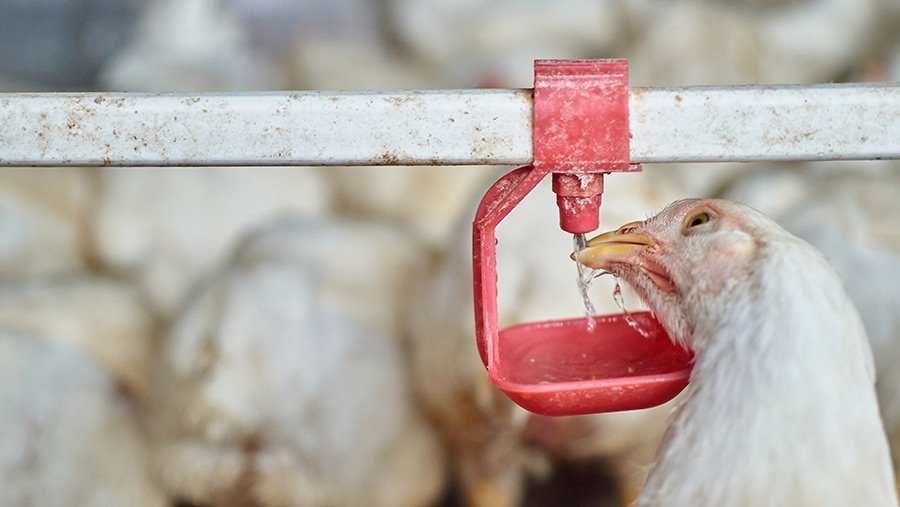4-point management plan for managing warmth stress in poultry

Local weather change is driving growing climate extremes, which has made warmth stress extra topical for UK poultry producers.
“Final 12 months, some broiler operations misplaced as much as 30% of their flock because of warmth stress,” says St David’s Poultry Crew vet Sean Knowledge.
“It was sizzling in anybody’s language; 40C just isn’t regular.”
See additionally: How poultry unit manages warmth stress with misting methods
Born and bred in South Africa, Sean certified as a vet there and spent 9 years consulting for broiler, broiler breeder and business layer operations all through the nation.
He’s now primarily based within the UK, and his expertise of poultry manufacturing in a sizzling local weather has change into a beneficial asset.
The business goes to need to cope with larger temperatures for the foreseeable future, he stresses.
“If you wish to be in poultry manufacturing for the subsequent 5 to 30 years, you must take into consideration long-term administration methods.”
The catastrophic losses skilled final 12 months grabbed headlines, however the subclinical efficiency losses from warmth stress, corresponding to decreased progress and egg manufacturing, most likely hit farmers tougher, he says.
“The place one farmer might have misplaced 30% of his broilers, 10 different farmers might have misplaced 50g of progress a chicken, and that’s very expensive to the sector.”
4 elements of management must be thought of: Lengthy-term management, comprising investing and appearing to handle danger; medium-term management being motion within the interval forward of danger; short-term management, which means motion shut as much as danger interval; and, critically, put up heat-stress administration.
1. Lengthy-term management
Home design
Poultry homes in sizzling nations are designed to deal with warmth – they’re formed for a lot higher air flow capability.
Nevertheless it’s not possible for established UK producers to only rebuild, says Sean.
“If a brand new web site goes to be constructed, or there’s a need to reinvest by changing outdated sheds or increasing a web site, hotter temperatures and the home’s design and local weather management system must be a severe consideration.”
The chilly hasn’t gone away, both, he provides.
“It is a explicit problem for UK producers. You may’t simply construct a farm to deal with sizzling climate; you’re additionally going to battle with the chilly.”
A higher temperature differential complicates home design.
“A chilly winter’s day can simply be -5C to -10C. So, with the potential for temperatures reaching 40C in the summertime, the home has to deal with a temperature vary of 50C. That’s difficult from an engineering perspective.”
Air flow must also be factored in. “Be sure to can create longitudinal [tunnel] air flow. This typically means having an extended, thinner home than traditionally constructed within the UK,” he explains.
Insulation
Insulation is significant – it retains warmth in throughout chilly climate and warmth out throughout sizzling climate.
“In South Africa, we’d advise producers to first take a look at their insulation to assist with warmth stress. In case your homes aren’t effectively insulated, they’ll change into ovens in the summertime.”
Sean advocates shopping for one of the best insulation you’ll be able to afford.
“Good insulation pays you again – it gained’t simply save on heating, it’s going to additionally save on cooling.”
Air flow
South African poultry operations have a lot higher air flow capacities than within the UK.
Tunnel air flow is finest for maximising local weather management, and needs to be included in new builds or retrofits – alongside adequate fan capability.
“Plan for the worst-case climate situation and err on the facet of additional fan capability.
“The local weather is barely prone to get hotter, therefore the necessity for higher fan capability to ship efficient and environment friendly cooling.
“In the event you’re investing for the subsequent 20-30 years, you wish to ensure that funding delivers the options wanted – now and effectively into the longer term.”
Cooling methods
Most cooling methods are primarily based on evaporative cooling: misters or moist partitions.
“There are benefits and drawbacks to each,” he says. “However an evaporative cooling system is necessary for any new construct or retrofit.”
Misting methods will be put in simply at each construct and retrofit degree, whereas moist partitions are a extra viable possibility for brand spanking new builds.
“Retrofitting moist partitions is much more troublesome and dear,” he provides.
From a administration perspective, misters require somewhat extra enter to keep away from moisture accumulation within the shed.
Different methods corresponding to air-conditioning usually are not sensible on a business scale.
Estimated earnings losses in sizzling climate Broilers Farm : Six homes every holding 30,000 birds
: Six homes every holding 30,000 birds Common value per kg : £1.10
: £1.10 Development loss per chicken : 50g
: 50g Misplaced earnings per home: £1,650 (£9,900 throughout six homes) Layers Farm : 16,000-bird free-range unit
: 16,000-bird free-range unit Common value per dozen : £1.40
: £1.40 Lack of saleable eggs by poor shell high quality/depressed manufacturing : 5%
: 5% Misplaced earnings per day: £92.40
2. Medium-term management
Stocking density
In South Africa, some broiler shoppers would lower their stocking density in summer season months by about 10%.
That’s not sensible for a laying operation, however it might be a consideration for broilers.
Chickens generate numerous warmth, so fewer birds in a shed means much less warmth, much less stress on air flow and more practical cooling.
“On an older web site, the place you’ll be able to’t make investments an excessive amount of, taking just a few birds out of manufacturing for one or two crops might cut back probably the most extreme results of warmth stress.”
He acknowledges there are monetary implications.
“The place capital can’t be invested, it is perhaps price contemplating what that 10% loss seems like compared to the 30% losses we’ve seen. It’s not a must-do, it’s about choices.”
Diet
Nutritionists may also help producers implement methods to take care of chicken efficiency throughout sizzling climate, however it must be deliberate two to 3 months forward of possible warmth stress circumstances, maybe in session with the farm vet.
Selections embrace completely different uncooked supplies, significantly power sources, that are essential for sustaining manufacturing when below stress.
How a lot needs to be invested? New infrastructure might contain severe capital funding, in addition to time and interruptions to manufacturing. So what’s the best degree of outlay? “The reply depends upon a number of components, taking a look at long-, medium-, and short-term controls,” says St David’s Poultry Crew vet Sean Knowledge. However one factor is obvious: “We should always count on to see additional temperature will increase in addition to [more] days a 12 months at these larger temperatures.” That is all set in opposition to a backdrop of excessive feed and power prices, in addition to added stress from labour challenges and the specter of avian influenza. “In the event you chat along with your vet and nutritionist, you’ll be able to put collectively a smart chicken administration and dietary plan, and be in a greater place to reap the advantages by way of sustaining efficiency. “That’s why it’s necessary to have a spread of choices, so producers could make the changes, enhancements and investments that go well with their birds and enterprise wants.”
3. Brief-term management
Energy
Producers ought to put together for decent climate just a few days earlier than it’s forecast.
“Begin along with your generator. It’s outstanding how typically electrical energy provide maintains by the winter solely to fail on the most popular day of the 12 months,” he says.
“If in case you have mechanical air flow and wish all of your followers working, that’s an enormous load on the generator, so be sure that it’s performing because it ought to and you’ve got sufficient diesel.”
Home temperature
Mature layers and broilers greater than 21 days outdated are at higher danger of warmth stress, as their growing measurement takes the home nearer to capability.
“If in case you have week-old broiler chicks, sizzling climate isn’t one thing to be as involved about, however should you’re at 26 days then there are massive issues.”
Decreasing temperature set factors by 1-1.5C is price contemplating for layers and broilers over 21 days in session with technical and veterinary advisers.
Humidity and local weather management
Excessive humidity compounds excessive temperatures, and ensuring the home is as dry as attainable will cut back humidity.
Take away moist bedding, and verify drinkers and contours in addition to puddles forming below air flow inlets.
When temperatures improve, make sure the air flow and cooling methods are working in synergy to maximise efficacy.
Electrolytes and water temperature
One other consideration is electrolyte dietary supplements – particularly these containing sodium and potassium – to take care of chicken hydration and efficiency. “These will be equipped by your vet,” Sean advises.
He suggests having two to 3 days’ price of complement handy and figuring out how a lot to make use of, although not beginning till larger temperatures hit.
Begin them too quickly and they’re going to stimulate the birds to drink, he warns.
“If further hydration just isn’t wanted at that time they’ll cross it of their droppings, which can increase the home moisture degree – precisely what we’re making an attempt to keep away from.”
For producers who’ve a header tank system, one other easy and efficient technique to cool water coming into the home is to freeze buckets of water and empty the ice blocks into the tank.
4. Put up heat-stress administration
Warmth stress impacts intestinal well being in birds. “It’s prudent to anticipate issues after the danger interval of warmth stress,” he suggests.
“The 2 foremost choices for supporting intestine well being on this interval are natural acids and important oils.
“You don’t wish to spend money on getting the birds by the new interval, for them to then develop nasty enteritis which causes efficiency loss and/or mortality.”




